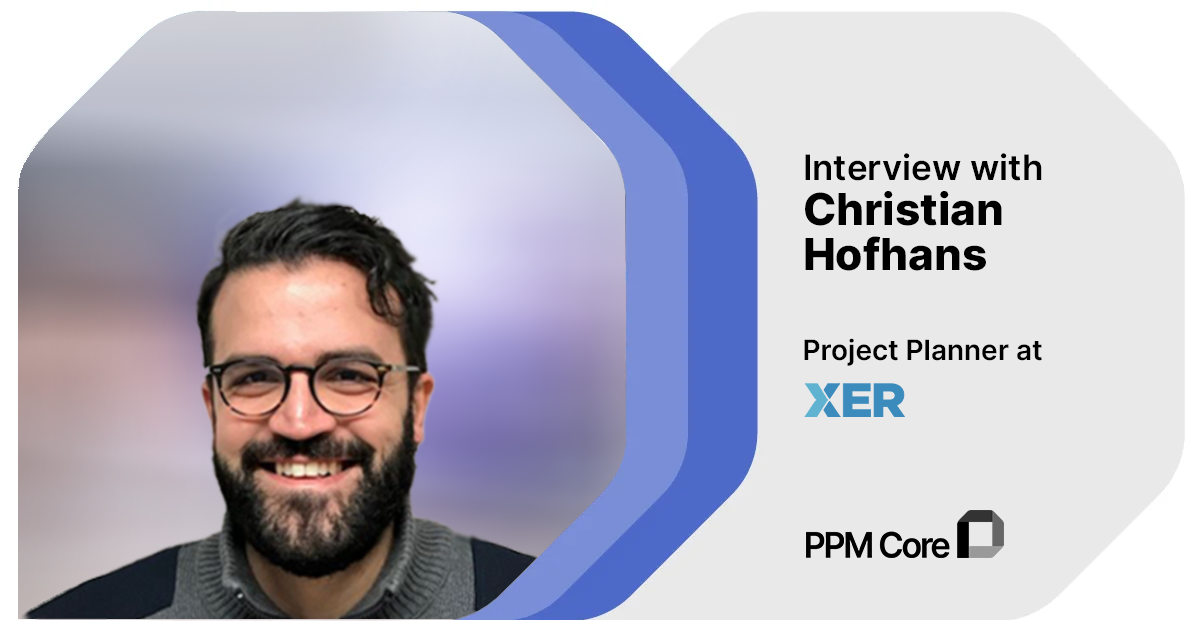Saving Time in Project Planning: PPM Core’s Benefits for Planners
Project planners often face challenges in managing and communicating data, particularly on complex projects where numerous schedules—typically stored as PDFs in various folders—can create confusion over which version is the most current. This is where PPM Core proves invaluable, offering a solution for updating and sharing the latest schedules with everyone involved in the project.
In this interview, we’re joined by Christian Hofhans, a seasoned Project Planner with 13 years of experience, who has been utilizing PPM Core for over two years. Christian will share insights into how PPM Core has transformed his approach to project planning, helping him navigate and manage complex projects more efficiently.
Read on to discover how Christian leverages PPM Core in his daily work and the specific ways it has enhanced his project planning processes.
1. Hi Christian, could you start by introducing yourself and sharing your extensive experience in project planning? What motivated you to pursue a career in this field, and can you provide an overview of the types of projects you have worked on so far?
I have been working as a planner and in a broader manner as a project control consultant for 13 years. I pursued my career in the nuclear power industry and later began to work with large and complex hospital projects. Although these are different types of projects, the challenges we face working with them are much the same. The thing that motivated me to pursue a career in project planning is mainly the variation in the work and the obstacles you meet on a daily basis, you get to discuss details of critical work packages and at the same time you have to look up and present the progress for the management team. This gives you a great insight of the project as well as many points of contact.

2. What do you think is the most common misconception about project planning, and how have you seen project planning evolve over the course of your career?
The most common misconceptions about the discipline of project planning is that planners build up project schedules, that’s only the tip of the iceberg. Except of creating and monitoring a project schedule a planner has to define the scope of the project, set up strategies, objectives and deadlines, allocate efficient labour and resource needs, set up project budgets, design layouts of the project schedule for stakeholders, build reports for the project management team, follow up and adjust the plan accordingly. During my time as a planner here in Sweden there has been a shift on the view of the planners role which have met general recognition. Planners are now an integrated and essential role of large complex multibillion projects which carry broad skills in project control.
3. Transparency, collaboration, and project data collection are all crucial aspects of project planning. Can you highlight what you believe are the most common challenges faced by project planners?
I would say that the most challenging aspect of being a planner is how you present information in a pedagogical way and also to make it available for all stakeholders. As a planner you struggle with a heavy workload which I mentioned earlier. You have to plan and monitor the progress of the project in different stages of the project which include engineering, procurement, construction and commissioning. At the same time, you must convey the information through various communication channels which includes subcontractors, project members and project management. Therefore effective time management and information handling is necessary.
4. How has PPM Core enhanced your work? Could you also share some details about the types of projects for which you use PPM Core?
PPM core has helped me make the project plan accessible to all project stakeholders and has been used in both the design procurement and construction phases of the project I am working on. It has been a dynamic tool compared to the PDF printouts I have used in the past and for the user has been easy to find the information needed in one place.

Do you find this article interesting?
Subscribe to our Newsletter for updates on the latest blog articles.
5. You’ve mentioned that PPM Core has significantly saved you time on your projects. Can you provide an in-depth overview of how it simplifies your work and highlight the functionalities you find most valuable?
Project information can be presented in different ways depending on who the recipient is. Instead of making different kinds of views of the schedule and uploading them to a portal with a complicated folder structure, I can now upload a file and share the information with the recipients. The recipients can then use the filtering function, the structure of which the user can adapt to be able to see the appropriate information about the project schedule. The information is available in one place and everyone knows that this is the latest version of the project schedule available.
6. How do you find the onboarding process for PPM Core, particularly in the context of complex projects like yours?
The simplicity of the tool makes it easier for the user and allows the user to easily find the functions and content they are looking for with a few keystrokes. I rarely hold long trainings, but have simpler briefings to explain the strengths of the tool and at the same time guide around to make the user familiar with the tool. This also saves me time in my work.
7. What additional benefits do you see in using PPM Core at the project level, and how does it impact other roles involved in the project?
Version management is important when it comes to schedules. In a context where pdfs have been exchanged and information has been stored in different folder systems and locally on the computer, there has always been talk of which is the latest version of the project schedule one is looking at. Nowadays with this tool everyone knows where to look for the latest version of the project schedule. The tool also allows an easy way to administer baselines and go back to previous versions of the schedule.
Another advantage is that it is possible to transfer metadata directly from primavera P6 or another tool in the form of codes so that the user can use the codes to filter out specific activities and moments for their role.
8. Given that PDFs are commonly used for communicating project data and often lead to various communication issues, do you think this method will become obsolete in the coming years?
PDFs have served their purpose but in an increasingly digitized world with greater demands for interactivity and being able to find the right information quickly by using metadata to filter and sort the information you are looking for, PDFs are not a competitive advantage. They are also difficult to adapt to make them readable on mobile platforms when working in the field.

9. What emerging trends do you see in project planning, particularly regarding the adoption of new tools and digitalization in your field?
Structures to make available and share data on common platforms are starting to gain momentum. The administration of project information is no longer done on separate scattered platforms. The focus has shifted from just having information stored to creating common platforms where it becomes easier and user-friendly to obtain information by using metadata.
